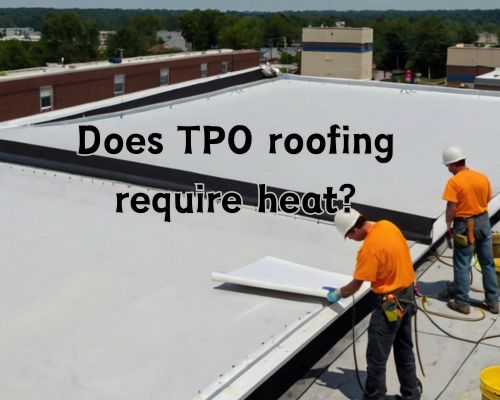
Does TPO Roofing Require Heat:
Essential Installation Insights
Thermoplastic Polyolefin (TPO) roofing has become a popular choice for both commercial and residential properties. Its affordability, durability, and energy efficiency make it a top contender in the roofing industry.
One key aspect of TPO roofing is that it does not necessarily require heat for installation. Traditional methods involve heat welding the seams. However, you can also use roof repair tapes that are compatible with TPO for a simpler and efficient alternative.

The installation process for TPO roofing involves preparing a clean and smooth surface, attaching rigid board insulation, and carefully rolling out the TPO membrane.
Its reflective properties make it ideal for reducing energy costs by keeping interiors cool during hot months.
Whether you are a homeowner or a business owner, TPO roofing can offer a cost-effective, long-lasting solution that performs well under various environmental conditions.
Choosing TPO roofing means opting for a material that resists UV radiation and withstands damage from the elements. This makes it particularly advantageous in regions with harsh weather.
So, whether you opt for heat-welded seams or repair tape, you can enjoy the benefits of this versatile and efficient roofing material. Let us know more with Charles Jimerson from CJ Commercial Roofing NJ.
Understanding TPO Roofing Material
Thermoplastic Polyolefin (TPO) roofing is a single-ply roofing membrane gaining popularity for its exceptional durability, energy efficiency, and flexibility. This section covers the key aspects of TPO roofing material, including its composition, benefits, and physical properties.
Composition of TPO Membrane
TPO roofing membranes are primarily made of a blend of polypropylene and ethylene-propylene rubber. These components provide an effective combination of rubber and plastic properties, enhancing durability and flexibility.
Additives such as flame retardants and UV absorbers improve TPO’s performance under various environmental conditions.
You’ll usually find TPO membranes in thicknesses ranging from 45 mils to 80 mils, tailored to specific structural and climatic needs. The white color of TPO membranes contributes significantly to their heat-reflective capabilities.
Benefits of TPO Roofing
TPO roofing offers numerous benefits. Its energy-efficient design reflects solar heat, reducing cooling costs for buildings.
The material is highly durable, typically lasting between 15 to 40 years. Flexibility is another strong point, allowing the material to adapt to temperature fluctuations without cracking.
Being eco-friendly, TPO is recyclable and does not involve hazardous chemicals in its composition. The cost-effectiveness of TPO makes it a compelling option for both commercial and residential roofing projects.
Physical Properties
TPO roofing boasts several important physical properties. It is reflective, which helps in reducing heat absorption. This characteristic makes TPO highly effective in promoting energy efficiency.
Flexibility enables it to withstand extreme temperatures, while its puncture resistance contributes to its long lifespan.
The membranes come in various colors, with white being the most common due to its superior heat-reflective quality. Thickness varies as needed, ensuring compatibility with different roofing requirements.
Installation and Maintenance of TPO Roofing
TPO roofing involves specific techniques for installation and requires particular maintenance practices to ensure longevity and effectiveness. Below are the key aspects of the installation methods, ongoing maintenance commitments, and related costs.
TPO Roofing Installation Techniques
Installing TPO roofing typically involves several essential steps, best performed by professional roofers due to the specialized skills required. See Charles Jimerson from CJ Commercial Roofing NJ.
- Preparation: Removal of old roofing materials and cleaning the surface.
- Insulation Installation: Placing an insulating layer to improve energy efficiency.
- Membrane Attachment: Rolling out and securing the TPO membrane to the roof surface.
- Seam Welding: Utilizing heat to weld seams, creating a watertight bond.
Expertise and the complexity of the installation process can significantly influence the overall cost.
Long-Term Maintenance and Repairs
TPO roofs are known for requiring minimal maintenance, especially compared to other roofing systems. Regular inspections for punctures, seam failures, and general wear are crucial.
Routine Maintenance:
- Inspections: Scheduled checks for damage, especially after severe weather.
- Cleaning: Keeping the surface clean to prevent debris accumulation.
Repairs:
- Seam Repairs: Fixing any seam failures with heat welding.
- Puncture Repairs: Addressing any punctures or leaks quickly to prevent further damage.
Cost Considerations and Life Expectancy
The initial TPO roofing cost includes both material and labor expenses.
Material Cost:
- It is typically lower than other single-ply membranes, making it budget-friendly.
Labor Costs:
- Professional installation is recommended due to the skill required. This impacts labor costs.
Cost-Effectiveness:
- While upfront costs might be significant, the long-term savings due to minimal maintenance and high energy efficiency make TPO roofing a cost-effective choice.
Life Expectancy:
- TPO roofs can last 20-30 years with proper maintenance. This is because they are resistant to UV radiation, chemicals, and punctures.